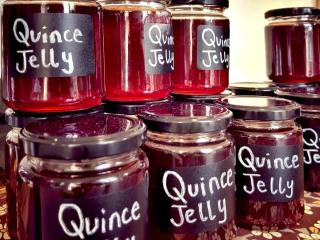

Quince jelly is, no doubt, one of the top ways to use those scrumptious fruits from your quince tree. This method allows you to enjoy your homemade jellies for many long months, a gift from a usually generous tree with a plentiful harvest.
Equipment:
→ Also worth reading: Health benefits of quince
Where you live matters a lot when harvesting quince. It’s important to pick them at the right time to have the biggest and ripest fruit possible. The ideal time is often signaled by the first fruit dropping to the ground. Another good reference is around the time the first frosts are hitting.
→ Keep the remaining pulp to make delicious fruit jellies.
Let the resulting juice rest for 24 hours…… A day later, everything’s set to start the actual cooking.
 Add the sugar at a rate of 1¾ lbs for 2 lbs of juice (800 g for every 1 kg juice) along with lemon juice and a vanilla bean sliced and chopped into pieces.
Add the sugar at a rate of 1¾ lbs for 2 lbs of juice (800 g for every 1 kg juice) along with lemon juice and a vanilla bean sliced and chopped into pieces.Stop the cooking when the mixture starts to gel on the end of your spoon.
Recipe offered by Chef Roger, our jam and jelly specialist.